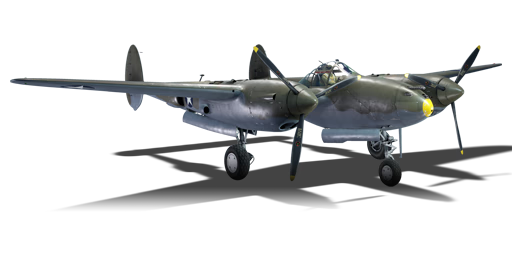



The P-38G was a minor evolution of the P-38 and was also widely produced with over 1,000 aircraft built. The P-38G was largely the same aircraft as the P-38F except the G ran at higher boost settings as well as having improved radio equipment. The Allison V-1710-51 in the P-38G (F10R) runs at a slightly higher manifold pressure (47.5) compared to the engine in the P-38F (47.0). Unfortunately, due to cooling issues with the engines at higher altitudes, the power was significantly limited. A decent portion of P-38G’s were actually F-5A Lightnings that were unarmed and fitted with five cameras for reconnaissance duties. These received the same improvements found in the P-38G and were built along the same production lines.
The P-38G-1 was present at the beginning of the Open Beta Test prior to Update 1.27. It’s a significant improvement over the previous P-38. It features better engines, a lighter airframe, and the ability to use rockets. The P-38G is a fairly strong plane due to its low BR and excellent climb performance. Furthermore, all of the guns are mounted in the nose which greatly helps with quickly downing enemy aircraft. Unfortunately, the P-38G is still an early version of the P-38 family and lacks the dive brakes which help against compressibility. However, players should still be satisfied with the P-38G’s performance.
flaps
flaps
flaps
brake
| Belt | Belt filling | Armor penetration (mm) at a distance: | |||||
|---|---|---|---|---|---|---|---|
| 10 m | 100 m | 500 m | 1000 m | 1500 m | 2000 m | ||
| HEF-I/AP-T | 39 | 36 | 25 | 16 | 10 | 6 | |
| AP-T/AP-T/HEF-I/HEF-I | 39 | 36 | 25 | 16 | 10 | 6 | |
| HEF-I/HEF-I/HEF-I/AP-T | 39 | 36 | 25 | 16 | 10 | 6 | |
| AP-T/AP-T/AP-T/HEF-I | 39 | 36 | 25 | 16 | 10 | 6 | |
| HEF-I | 5 | 4 | 3 | 3 | 3 | 3 | |
| Belt | Belt filling | Armor penetration (mm) at a distance: | |||||
|---|---|---|---|---|---|---|---|
| 10 m | 100 m | 500 m | 1000 m | 1500 m | 2000 m | ||
| T/Ball/Ball/I/AP-I | 28 | 26 | 18 | 11 | 7 | 4 | |
| AP-I/AP-I/AP-I/T/I | 28 | 26 | 18 | 11 | 7 | 4 | |
| T/AP/AP/AP/AP-I/I | 30 | 27 | 20 | 13 | 9 | 6 | |
| T/T/T/T/T/AP-I | 28 | 26 | 18 | 11 | 7 | 4 | |
| AP/AP-I/AP-I/I/I | 30 | 27 | 20 | 13 | 9 | 6 | |












Flight performance | |
|---|---|
Survivability |
|---|
Weaponry | |
|---|---|